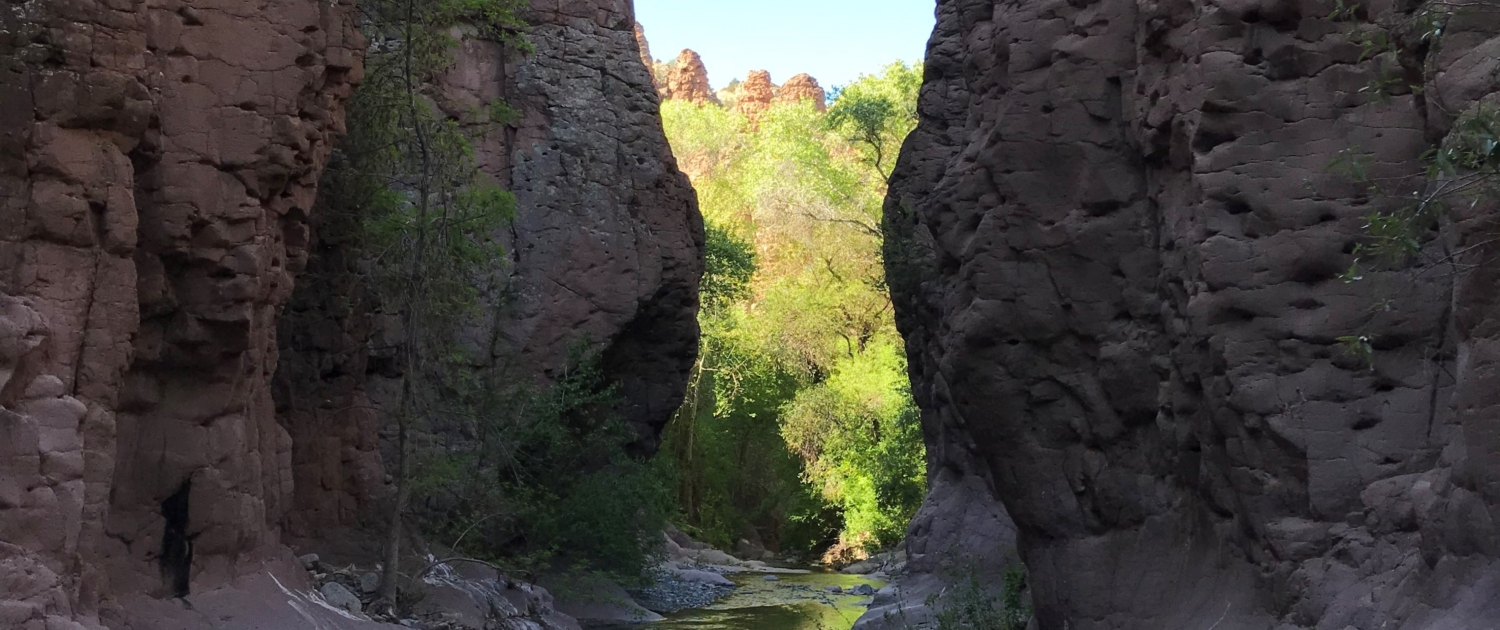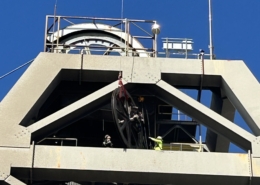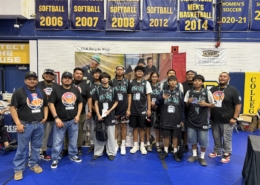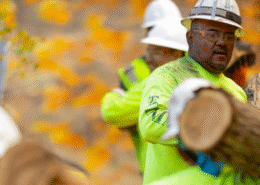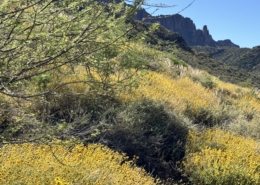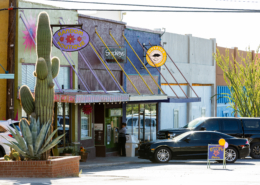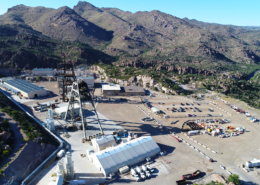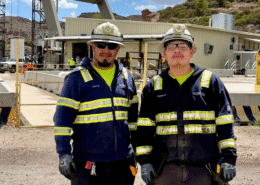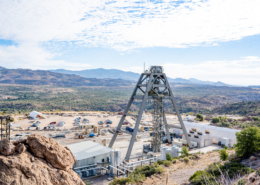Myths and Facts
Resolution Copper has been working with our communities for over a decade, as we safely and responsibly develop one of the largest copper mines in North America. Resolution Copper will bring jobs and long-term economic benefits to Arizona’s Copper Triangle region and continue the long history of supplying American copper to power growth and development across our nation.
The project has been shaped by a rigorous, transparent, and multi-year federal permitting process.
Cultural Heritage
Myth: Oak Flat will be destroyed by the mine.
Fact: Resolution Copper has worked to minimize impact to the Oak Flat area. We have reduced the original land exchange area to 2,422 acres. Apache Leap, a culturally significant area, has been completely avoided and will be placed in permanent protection. Resolution Copper has agreed to relinquish land and mineral rights to protect Apache Leap. There will be no physical impact to Devil’s Canyon, Queen Creek or US 60. Resolution Copper will forego portions of copper-bearing ore to minimize subsidence impacts to important areas within Oak Flat. The maximum expected area impacted by subsidence is about 1,800 acres at the end of the life of the mine.
Mining operations and active mining claims have co-existed with outdoor recreation, ranching and cultural activities in the Oak Flat area for decades. When we proceed with developing the project, we will maintain access to Oak Flat. Resolution Copper has and will continue to work with all interested and affected parties, including Tribes, to understand the area’s historical and cultural importance. We know and appreciate that areas within Oak Flat hold great significance to some members of the San Carlos Apache Tribe. Learn more here.
Myth: Apache Leap will be destroyed or damaged by the mine.
Fact: Apache Leap will be permanently protected. At the request of and in consultation with Native American tribes and local communities, we worked with the government to set aside more than 800 acres of land to permanently protect Apache Leap as a Special Management Area (SMA) that is managed by the USFS. Specific measures within the Apache Leap SMA accommodate tribal concerns regarding public access, grazing, and other protections for locations of cultural importance. Apache Leap will be monitored to ensure that future mining-related activity does not impact the feature and this monitoring will continue throughout construction, operation, closure, and reclamation of the mine. Detailed monitoring reports will be publicly available through the USFS.
Myth: The concerns raised by Native American tribes have not been heard or considered.
Fact: Consultation, collaboration, and coordination with Native American Tribes and local communities on the Resolution Copper project has been lengthy, transparent, and inclusive. To date, over the last eleven years, there have been over 550 documented consultations with Native American Tribes and many more with local communities that have drastically altered the project scope, including a complete change of technology and location of critical facilities, avoiding hundreds of ancestral sites (two dozen sacred areas, plants, seeps, and springs). Of particular importance is the protection of Apache Leap in a Special Management Area (SMA) managed by the US Forest Service. Apache Leap contains one of the most significant Western Apache archaeological sites in the entire region. Resolution Copper will forgo private ownership and mineral title as a result of the SMA designation.
Resolution has also been engaging Native American Tribes with ancestral ties to the project area through two-way dialogue, and information-sharing around cultural heritage and preservation of ancestral ties on Resolution Copper private property.
Learn more about how we’re working to preserve the area’s cultural heritage here.
Myth: Once the land exchange is complete, the public will no longer have access to areas in Oak Flat, including the campground.
Fact: Mining operations and active mining claims have co-existed with outdoor recreation, ranching, and cultural activities in the Oak Flat area for decades. When we proceed with developing the project, we will maintain access to Oak Flat. We have been committed to mitigating this project’s impact from day one and will continue to do so through the end of our operations. We are working collaboratively with the community to continually seek ways to make our operations more sustainable, including increasing biodiversity, and continuing to reduce our carbon footprint.
Water
Myth: Resolution Copper Mine would take billions of gallons of groundwater while Arizona faces unprecedented drought.
Fact: Resolution Copper’s focus is on reducing water usage across our operations, minimizing evaporation, and reusing and recycling water whenever possible. We have already stored enough water to sustain our operations, assuming maximum production for more than half the mine’s operating life. And the EIS published by the US Forest Service demonstrates there is adequate water supply for all cumulative uses for the next 100 years. Moreover, since 2009, Resolution Copper has provided approximately 7 billion gallons of water to local farmers. In using our treated water, farmers can pump less water for their own needs, leaving more water in the ground for later use. We are employing the latest technology that is proven to increase recycling and reduce water use, but we strive to do more. It will be at least a decade until Resolution Copper begins formally operating, and we are using this time to actively explore other ways to further reduce our water use and needs over time.
Myth: Tailings are toxic and will result in widespread damage to groundwater and surface water.
Fact: Tailings are highly regulated, as well as precisely located and engineered to prevent impacts to groundwater and surface water. Resolution Copper must comply with the National Environmental Policy Act (NEPA), the Clean Water Act, Endangered Species Act and state laws for water quality and water use, which in turn, requires rigorous water studies and substantive plans to monitor and protect groundwater, surface water and seeps and springs important for wildlife and cultural heritage. As such, Resolution Copper has invested in an extensive surface and groundwater monitoring network. Not only will this be monitored by state and federal regulators, but we have also gone even further by implementing a Community Working Group (CWG) that monitors our current activities and will monitor future operations.
Permitting
Myth: The permitting process was fast-tracked by the Trump Administration.
Fact: Since 2013, the US Forest Service (USFS) has led a rigorous independent review of the Resolution Copper project under the National Environmental Policy Act (NEPA), which has included years of public consultation and extensive engagement with a broad range of stakeholders, including Native American tribes and relevant federal, state, and county agencies. In the project schedule, initially set by the USFS during the Obama Administration, the target date for Final Environmental Impact Statement (FEIS) was July 2020. The FEIS was published on January 15, 2021, six months behind the original schedule. The USFS then rescinded the EIS on March 1, 2021 to allow for further consultation and review. The next step in the permitting process is the republication of the Final Environmental Impact Statement (FEIS) and Draft Record of Decision (DROD), which will formally restart the federal review. On April 17, 2025, the U.S. Forest Service issued a legally required 60-day notice of its intent to republish both documents. Once republished, the public will have 45 days to submit objections, after which the agency must review and respond before issuing a Final Record of Decision.” You can learn more about the multi-year permitting process here.
Myth: The land exchange was slipped into legislation in the middle of the night.
Fact: Legislation to facilitate the land exchange between the Tonto National Forest and Resolution Copper was passed with bipartisan support in December 2014 and was signed into law by President Obama. The Southeast Arizona Land Exchange and Conservation Act is one of more than 80 land bills that were part of the National Defense Authorization Act (NDAA) in 2014, and members of the Arizona Congressional delegation, both Democrats and Republicans, championed it for close to a decade. The purpose of the lands package was to convey lands administered by the United States Forest Service and the Bureau of Land Management directly to local governments, ranchers, public utilities, educational institutions, Native American Tribes (and Alaska Native Corporations), and mining companies in exchange for private lands with conservation value or cash to purchase conservation lands. The land exchanges allowed for school district and university growth programs, expansion of farming/ranching, recreational opportunities such as trails and shooting ranges, oil and gas and logging opportunities for Native Alaskan Corporations, infrastructure support for public utilities, economic development for rural governments, and exploration and mineral development. The final language in the Southeast Arizona Land Exchange and Conservation Act for Resolution Copper and the Town of Superior included important changes based on a decade of feedback from a wide range of stakeholders, including the San Carlos Apache Tribe and environmental groups. It is the only Congressionally mandated land exchange bill requiring a comprehensive environmental review under NEPA and compensatory mitigation to address the concerns of Native American tribes through government-to-government consultation. You can learn more about the legislation here.
Myth: The public gets nothing in return for the Resolution Copper land exchange.
Fact: The federal government will receive over two times the amount of land that will be transferred to Resolution Copper – 5,459 acres of conservation lands from around Arizona will be transferred to the federal government and become part of existing National Forests or National Conservation Areas, providing long-term conservation, habitat and cultural heritage protection, and recreational opportunities, in exchange for transferring 2,422 acres from the Tonto National Forest into Resolution Copper’s ownership. Additionally, if requested, the Town of Superior will be granted land from the Federal Government to use for economic expansion and diversification opportunities.
USFS, US Fish and Wildlife Service, Bureau of Land Management, Audubon and The Nature Conservancy, and others informed the selection of the 5,459 acres of conservation lands. All parcels are going through an independent appraisal process directed, managed, and approved by the US Secretary of Agriculture to ensure the lands exchanged are of equal value. If the federal lands’ appraisal value is determined to be higher than the Resolution Copper lands, the company will make up the difference through payments to the US Treasury.
Notably, the land exchange legislation creates a mechanism by which the federal land appraisal links to Resolution Copper’s future production. In the future, if the mine’s cumulative production of commercial quantities of minerals exceeds the amount estimated in the appraisal, Resolution Copper must make an annual adjustment payment to the United States. Learn more here.
Resolution Copper is committed to preserving Native American cultural heritage while developing partnerships and bringing lasting benefits to the entire region.
General
Myth: The local economic benefits of the project will be short-lived.
Fact: Resolution Copper has the potential to be a truly multi-generation project, with an estimated life of over half a century. When the mine is fully operational, Resolution Copper expects to support roughly 3,500 direct and indirect jobs, paying around $280 million per year in total compensation. The project is expected to contribute up to $1.2 billion annually in economic value for Arizona over the project’s 60-year estimated life. Learn more about the local economic impact of the project here.
Myth: Resolution Copper is foreign-owned.
Fact: Resolution Copper is Arizona copper. Resolution Copper will be a significant addition to Rio Tinto’s flagship United States project, Kennecott, which employs over 2,000 people outside of Salt Lake City. The copper mined at this Arizona project will benefit US supply chains, and provide critical materials needed to decarbonize and grow the economy. Resolution Copper will deliver significant economic growth to nearby communities and the state of Arizona by providing tax revenue, increased local spending and jobs. The project will directly employ about 1,400 employees and generate approximately 2,100 indirect jobs in Arizona. Resolution Copper is a joint venture owned by two global companies, Rio Tinto (55%) and BHP (45%). Rio Tinto Group is an Anglo-Australian multinational metals and mining public company and BHP is an Australian multinational mining, metals, and natural gas petroleum public company. While both companies have operations and investors on nearly every continent around the world, Rio Tinto and BHP are committed to being transparent, ethical, and responsible corporations that provide the materials that shape modern society. A majority of Rio Tinto and BHP shares are held across the Australian, United Kingdom, and United States exchanges.
Myth: The US does not need to mine for copper; recycling copper can sufficiently meet demand.
Fact: Once in operation, the Resolution Copper mine will be one of the largest mines in the United States. That’s vital fuel for American innovation. Copper is an essential component in mobile devices, medical equipment, and clean energy technologies, and demand is growing worldwide. According to the International Copper Study Group (ICSG) only 35% of the current total demand is met by recycled copper.1 The World Bank estimates that global copper demand could rise by 200% by 2050.2 Although copper is 100% recyclable, recycling alone will not be enough to meet the demand.. Nevertheless, recycling is an important complement to the production of copper. Both recycling of copper and continued mining for new copper will be needed at levels significantly beyond current levels as the world moves towards a low-carbon energy future.
Myth: The project will cause the greatest loss of rock-climbing access ever in the US.
Fact: Most if not all areas currently used by rock climbers will remain accessible long into the future — and many may never be impacted. Additionally, ahead of any mining, at the request of rock-climbing groups, Resolution Copper is developing access into an area called the Inconceivables. We have also partnered with a national outdoor retail co-op on a land access agreement wherein the retailer conducts rock-climbing classes on Resolution Copper property.
Myth: The mining method is unproven.
Fact: Arizonan mining has played a major role in the development of block caving, and block cave mining has been used in Arizona spanning back over a century. Mines in the Copper Triangle including the Inspiration Mine near Miami and the Ray Mine near Kearny began as caving operations. Additionally, the San Manuel Mine was mined for decades using block caving. Caving is a well-established technology that has been around for over a century and is currently used at over 20 mines across the world. One example of an active caving mine in the United States is the Hendersen mine in Colorado, which is owned and operated by Freeport McMoRan. Rio Tinto has operated three-block cave operations in Australia and South Africa, and Resolution Copper will be a modern, leading-edge operation utilizing the most sophisticated technology available.
Myth: The company has no obligations to the community once mining ends.
Fact: We recognize our impact and responsibility do not end when our operations cease, so we consider closure in the way we design, build and operate the project. We’re working collaboratively with the community to ensure our legacy is one of positive, lasting benefits. That means finding ways to make our operations more sustainable as we move closer to production and making sure there is a plan in place to ensure the long-term safety and resilience of the land around us. State and federal law require a final reclamation plan to be approved before any mining can begin. And Resolution Copper—not taxpayers—must cover all costs associated with closing the mine and all post-closure monitoring.
To demonstrate our commitment to responsible operations and to making our community a cleaner and safer place to live and work, Resolution Copper voluntarily invested approximately $75 million over 15 years to restore 475 acres of the old Magma Copper West Plant. As a result of our reclamation efforts, an area that formerly stored mine tailings are now home to thriving native vegetation and wildlife. And by hiring local workers for the project, we’ve created jobs for our neighbors.

